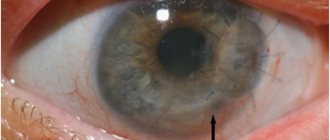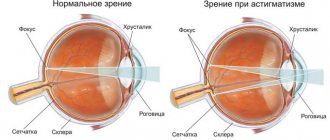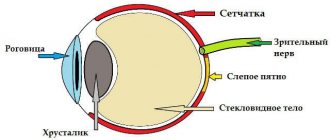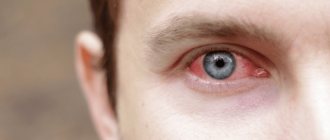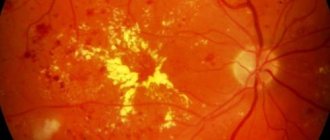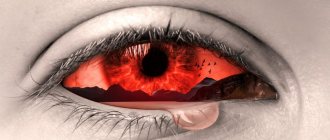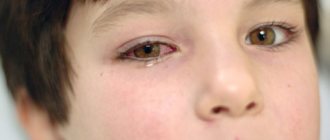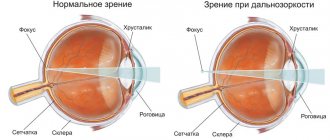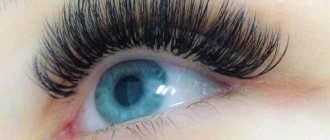The human eye is a very complex and fragile structure that is easily damaged. An eyeball bruise is one of the most common injuries to the visual organs, which can lead to serious consequences, including complete loss of vision.
You will learn from this article how to determine if you have an eyeball bruise, as well as first aid techniques for this injury, treatment methods of official and traditional medicine, and other useful information.
Causes of eye injury
The causes of eye injury are different, but the main ones are the impact of a foreign object on the organ. You can get a bruise to the eyeball due to a blow:
- hands;
- branches;
- ball;
- stone;
- when falling, etc.
The degree of damage depends on the force of the impact. In case of injury, the sclera, cornea, lens, blood vessels, optic nerve, retina and lacrimal system may be damaged.
The eye area is surrounded by tissue that has a small subcutaneous fat layer and many blood vessels. Eye injury is accompanied by hemorrhage and rupture of dense tissue. In the professional sphere, an eye injury is called a concussion.
Antimicrobial drops “Okomistin”
These drops can be used for injuries to the cornea of the eyes, since they do what they are supposed to do very well, namely, prevent the occurrence of various complications and inflammatory processes. Recommended for use in cases of chemical and thermal burns of the organs of vision, acute and chronic conjunctivitis, lesions of the mucous membranes by chlamydia, viruses and bacteria. The number of drops, treatment regimen and duration of therapy in this case can only be indicated by your attending ophthalmologist.
Symptoms of an eye injury
The main symptoms are:
- pain;
- lacrimation;
- photophobia;
- hemorrhage or bleeding;
- partial loss of vision;
- involuntary closing of the eyelids;
- headache;
- loss of consciousness, dizziness;
- edema.
If an eye injury occurs without a combination with a penetrating wound or damage to the eyeball, then when the pain disappears, the injury is not given much importance, but the consequence may be deterioration of vision. This process occurs due to hemorrhage in the internal areas, the formation of a clot and the formation of connective tissue, which affects the functioning of the lens and provokes retinal detachment or the development of cataracts and glaucoma.
Eye contusion is classified as direct or indirect. Direct injury occurs when an object hits the eye. Indirect – when the face or head is damaged.
Prevention and prognosis
The prognosis for successful recovery depends on the nature and degree of injury to the visual organs. If the damage is superficial, not severe, and the victim seeks medical help in a timely manner, the risk of developing negative consequences is minimized, and after a while the person will be able to see fully. Otherwise, complications develop, as a result of which vision may be completely lost, and the person will become disabled.
As a preventive measure, it is necessary to follow safety rules: when performing traumatic work, always use safety glasses and a helmet, while walking, look carefully in front of you, and move carefully in places where there are a lot of branches and bushes. In addition, it is important to protect the organs of vision from intentional impacts, always wear seat belts in the car, and those who like to ride a motorcycle should not forget about a special helmet, which in the event of an accident will take the main load when hitting the head. Children should also be aware of the rules of safe behavior at home, in the yard and at school.
First aid
If you receive an eye injury, pre-medical measures are taken, followed by mandatory seeking help from a specialist.
First aid for an eye injury should be performed with clean, washed or antiseptic hands.
Under no circumstances should you:
- use cotton wool;
- use alcohol-containing solutions;
- independently remove foreign objects from the damaged area;
- press and rub your eyes.
If you receive an injury, many can provide first aid, they know the basics of healing and rehabilitation methods, but still, not everyone knows what to do if they bruise their eyes.
The complex of first aid measures for eye injury includes:
- applying a bandage to protect from light;
- exclusion of physical activity;
- for the purpose of prevention, it is possible to instill Albucid into the eyes;
- stopping bleeding;
- use of anesthetic.
The injured person must take a horizontal position and apply ice wrapped in cloth to the bruised area.
If an alarming state occurs, the victim must be given a sedative and taken to a medical facility for professional assistance.
Diagnostics
At the ophthalmic trauma center, a medical history of the injury will be taken, initial measures will be taken to treat the damaged area and, if necessary, the foreign body will be removed from the injured eye.
By contacting a specialized institution, you will receive a full range of examinations, consisting of:
- ophthalmochromoscopy,
- tonography;
- rheography;
- ultrasound examination;
- X-ray diagnostics.
After diagnostic measures are carried out, a diagnosis is established and treatment is prescribed.
Treatment
Eye injury is divided into types:
- superficial damage;
- penetrating;
- stupid;
- burns
Superficial injury occurs due to the introduction of a foreign object into the mucous membrane - soil, metal particles or stone.
Superficial damage may result in insect entry. Acute pain, tearing and photophobia occurs, irritation and hyperemia of the mucous membrane occurs. With this type of injury, the foreign body is removed and a bandage with an antiseptic is applied. Penetrating eye injury occurs due to disruption of the integrity of the eye by cutting or piercing objects, as a result of which the eyeball suffers. Characteristic symptoms are severe pain, decreased or loss of vision. In this case, hospitalization is prescribed.
Blunt trauma occurs when the eye is exposed to a blunt object: a hand, a stick, etc. This type of injury occurs without visible damage to the eye and failure to promptly seek qualified help can lead to deterioration of vision. It is accompanied by painful sensations and “bloating” of the eye.
An eye burn occurs when the mucous membrane is exposed to chemical, thermal or radiation irritants. In case of a chemical burn to the eye, rinse with water and seek medical help.
In case of complex damage, hospitalization and, in some cases, surgery are prescribed. If a minor injury occurs, dispensary treatment is carried out under the supervision of specialists, which will quickly restore the injured organ.
The complex of eye treatment includes the use of:
- compresses of cold water, hydrogen peroxide;
- antibacterial and anti-inflammatory ointments;
- antibiotics;
- drugs that reduce eye pressure and restore blood vessels.
Drug treatment is carried out only under the supervision of a doctor.
How to put drops into eyes correctly?
Despite the fact that all drops have different effects, they all use the same principle. The procedure is as follows:
- Rinse your eyes with running water and remove lenses, if you wear them.
- Disinfect your hands. The best way to do this is by washing them and treating them with an antiseptic gel (“Orphan”, for example).
- Take the bottle and open the cap in the desired direction (indicated in the instructions).
- Tilt your head back (you can just lie down on a sofa or bed).
- Pull the lower eyelid slightly (you need to look up).
- Place a few drops of the drug in the corner of the eye, near the bridge of the nose.
- Close your eyes and lie down for 5 minutes for better results.
Please note that when instilling drops with the tip of the bottle, it is better not to touch the eyelashes, upper eyelid and skin.
Traditional medicine recipes
At home, it is also possible to treat with traditional methods that remain relevant in modern life:
- a compress of calendula infusion (1 tablespoon of calendula per 100 ml of water) will relieve swelling and inflammation;
- Applying burdock leaves to the damaged area will relieve pain. The pre-washed sheet is applied with the back side and covered with polyethylene and a warm cloth;
- To improve blood supply to the affected area and in the absence of bleeding, a paste of ginger and turmeric is used (0.5 teaspoons of turmeric and ginger and 1 teaspoon of water). The product is applied to the fabric, applied to the closed eye, polyethylene and a scarf are placed on top;
- for pain, onion gruel with the addition of a small amount of sugar will help;
- A compress of cabbage leaves will remove bruises. First mash the leaves until the juice is released and apply for 2 hours once a day;
- To eliminate hematomas and relieve inflammation, a 10% salt solution is used in the form of lotions;
- Iodine mesh is applied to the closed eyelid to restore blood circulation and healing. The mesh must be applied carefully so that the solution does not get into the eye;
- A poultice of cabbage leaves will help get rid of bruises. The leaves are poured with boiling water and heated. After heat treatment, they are kneaded and applied to the damaged area;
- Using masks made from sour cream and chopped parsley (1:2), tomato puree with a small amount of lemon juice, lentil flour and turmeric will help remove bruises. Masks are applied around the eyes.
It is impossible to treat an eye injury using folk remedies alone. Strictly follow the doctor’s recommendations and at the same time apply the experience acquired by the people.
Quick help for eye injury: treatment at home with medications and folk remedies
Depending on the severity of the eye injury, a person may face partial or complete loss of vision.
Some injuries can be cured on your own; in case of severe injuries, be sure to consult a doctor.
Drug treatments
Restore damaged tissues of the organs of vision with the help of medications in the presence of the following symptoms:
- tumors and swelling of the lower or upper eyelid;
- inflammation of the eyeball;
- increased tearfulness.
Depending on the degree of injury and type of damage, drops or medications are used.
Anti-inflammatory drops
The most famous eye treatment is drops. They eliminate inflammatory processes, gently affecting the organs of vision. Depending on the degree of injury, the types of drops are selected:
- If there is a speck or a slight chemical burn, use Albucid. It relieves swelling and has an anti-inflammatory effect. You can also use a regular solution of furatsilin. When using it, you need to ensure that the liquid gets exactly into the conjunctival sac.
- With sunburn or scratches on the eyelid, the protective functions of the eye are weakened, which promotes the proliferation of pathogenic bacteria. For such injuries, diclofenac solution (0.1%) or indocolir solution (0.1%) is used.
Photo 1. Diclofenac eye drops, 0.1%, 5 ml, from.
Drops are the easiest way to relieve inflammation in the eye after injury. But sometimes even more gentle treatment is required. In this case, medications are used.
Other medicines
Most often, this group includes ointments and painkillers. The former serve to reduce inflammation and destroy pathogenic microflora. Painkillers relieve pain and are used as adjunctive therapy.
Ointments according to their principle of action are:
- Antibacterial: tetracycline; erythromycin; Phloxal.
- Anti-inflammatory (hydrocortisone ointment).
Photo 2. Floxal eye ointment, 3 mg/g, 3 g, from .
If there are no ointments or drops in the medicine cabinet, you can use traditional medicine.
Traditional methods for mechanical eye injuries
This includes rinses, compresses, lotions.
Washing
Cleaning the eye with plain water is one of the simplest and most accessible ways to relieve inflammation.
Warm water removes fine debris and tiny specks of dust from the eye slit.
Washing is recommended for minor bruises associated with small foreign objects entering the organ of vision.
When washing your eyes, you should adhere to certain rules:
- It is necessary to rinse the organ of vision only with warm, boiled water.
- a separate cotton pad or swab for each eye
- Warm liquid is instilled into the eye while the patient looks up.
Reference! Don't put too much water in one eye . It is enough to carry out the procedure twice on each.
Tea compress
The most famous way to reduce inflammation of the eyeball. Tea is popular due to vitamin P , which helps remove free radicals from cells and also restores the structure of damaged tissues.
Tea strengthens capillaries, reduces eye inflammation and normalizes internal blood flow.
When preparing tea compresses, you need to remember some nuances:
- The tea leaves are not very strong, but also opaque.
- Compresses are made from cotton swabs or disks. A separate compress is applied to each eye.
- The temperature of the liquid should be 2–3 °C higher than the human body temperature.
- Tampons or discs are soaked in tea and wrung out. They are kept for no more than 5 minutes until the tampon or disc has completely cooled.
Attention! Under no circumstances should you put tea bags over your eyes. They contain dyes and fragrances, which will only worsen the condition. For a compress, loose or packaged tea of any grind is suitable.
Potato, apple or pear compresses
To prepare these compresses, you only need vegetables, fruits and a knife. The fruits are washed and cut into circles, after which they are applied to the inflamed eye.
For the best effect, grate the pulp of an apple, pear or potato. The resulting pulp is squeezed out and applied to the sore spot.
The listed fruits and vegetables have an excellent anti-inflammatory and tonic effect.
To prepare a compress, it is best to use fresh apples, pears or potatoes.
Camomile tea
Chamomile infusion reduces irritation and inflammation. It is worth noting that pharmaceutical chamomile , since it contains a larger amount of essential oils.
A simple recipe for making chamomile infusion for the eyes:
- Pour boiling water over the inflorescences of the plant and let it brew for 30 minutes;
- strain the infusion;
- drop the infusion into the eyes, 2-3 drops at a time, or apply warm compresses.
Photo 3. Chamomile flowers brewed in boiling water in a metal bowl should be infused for about 30 minutes.
Marshmallow root lotions
Althaea is known for its antibactericidal and anti-inflammatory properties . It is used to treat the throat, as well as to prepare lotions for injured eyes.
To make lotions you will need 10 grams. chopped plant and one liter of boiling water. The marshmallow root is filled with water and left in a dark place. After 30 minutes, the infusion is used to prepare lotions.
Features of treating eye bruises at home
Treatment at home requires special conditions. These will vary depending on the type of injury :
In case of mechanical damage to the organs of vision:
- do not pick out large specks with your fingers;
- after removing the foreign body, rinse your eyes with water or make a compress of tea;
- use drops or ointment to prevent infection or inflammation.
In case of injury:
- Apply a cold compress or a piece of ice to the organ of vision to relieve swelling;
- lie down on the bed so that blood does not rush to the injured eye;
- Apply a cool compress of chamomile or fresh cucumber to relieve swelling.
The listed recommendations promote a speedy recovery and minimize the risk of complications.
Important! The ingress of additional debris or bacteria can increase inflammation or swelling of the diseased organ, so be sure to wash your hands with soap before any procedure.
From the video you can learn what to do in case of eye bruises so that negative consequences do not arise later.
Conclusion
The listed methods are suitable for treating minor injuries , burns and inflammations. More serious injuries require mandatory medical examination.
Source: https://linza.guru/travmi/lechenie/v-domashnih-usloviyah/
Eye injuries in children
Particular attention should be paid to eye injury in a child.
Children cannot always determine the location of pain and often spread the infection throughout the body. If you do not contact a specialist in a timely manner, treatment can be protracted and complex. Any deviations from the norm (redness, blurred vision, rolling eyes, frequent blinking) should cause concern and immediately consult a doctor. Children should be examined regularly (once a year) by an ophthalmologist to avoid deterioration or loss of vision. If you injure your eye, immediately consult a doctor and follow all his instructions. Do not forget that delay can lead to irreversible processes. Vision is an indispensable source of information about the world around us.
